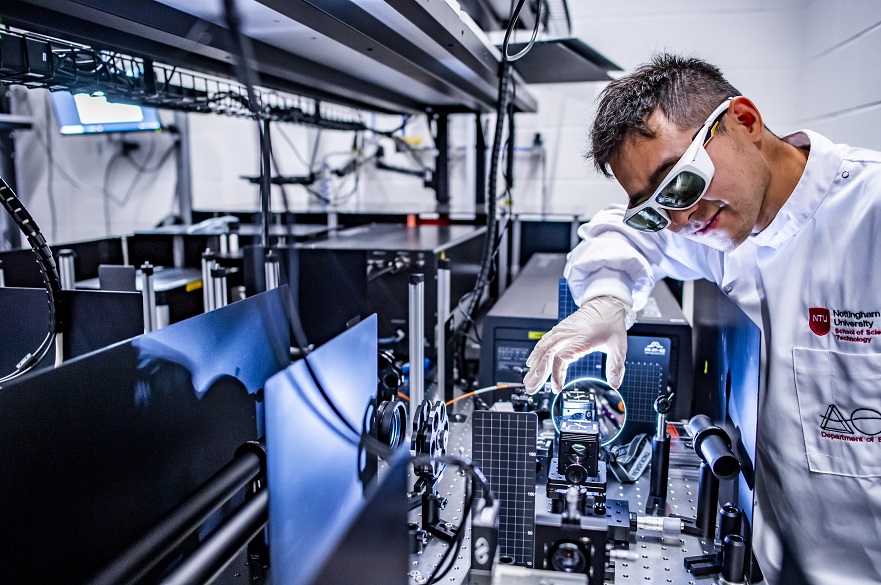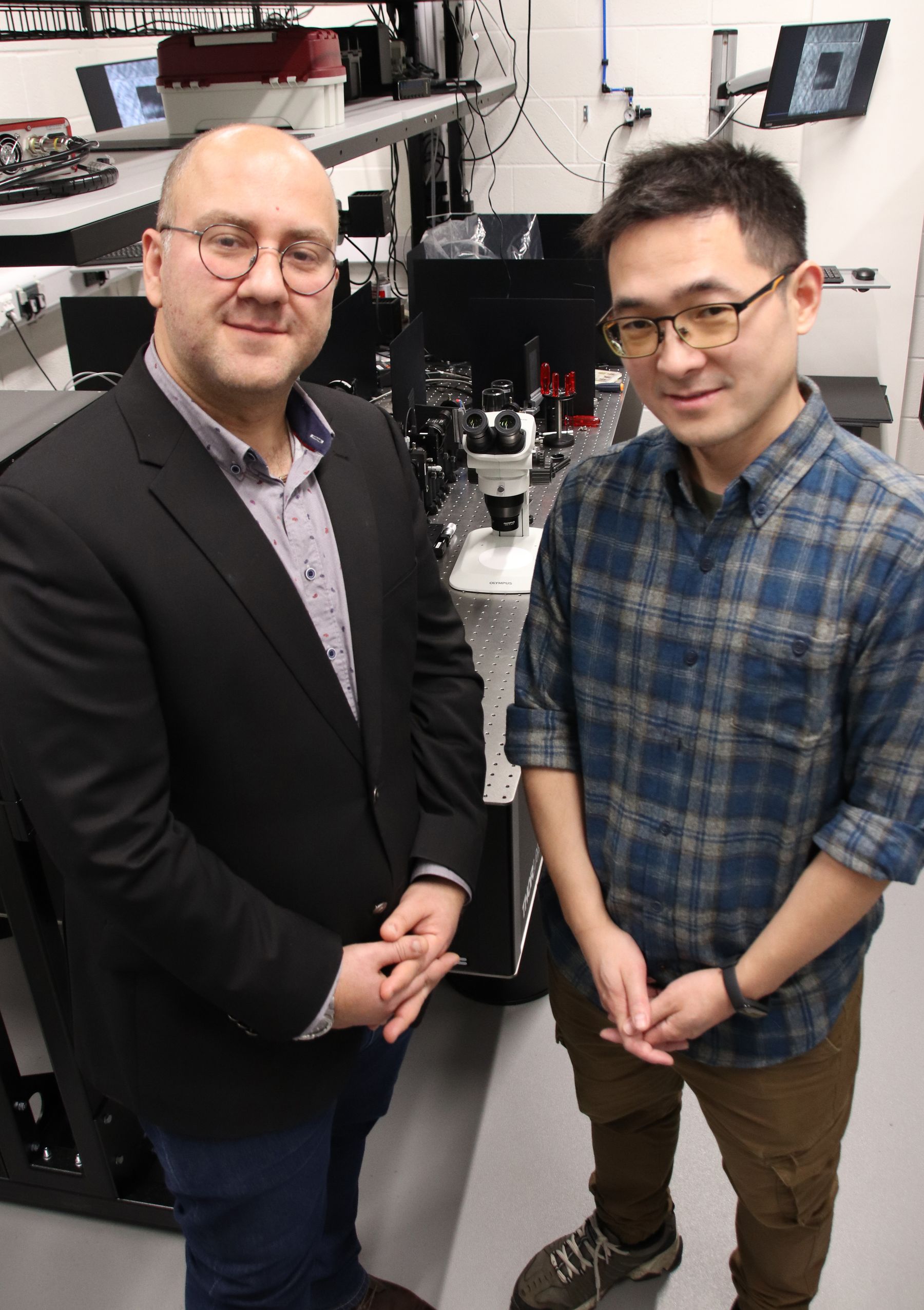Research could spark ‘next generation’ flat screens, which are significantly thinner and cheaper to run
Researchers have developed a proof of concept technology that could pave the way for ‘next-generation’ displays beyond current LCDs and LEDs, enabling screens and electronic devices to become thinner, offer higher resolution and be much more energy efficient.
By Dave Rogers | Published on 22 February 2023
Categories: Press office; Research; School of Science and Technology;

A team at Nottingham Trent University, the Australian National University and the University of New South Wales Canberra in Australia has engineered electrically tuneable arrays of nanoparticles called ‘metasurfaces’ which can offer significant benefits over current liquid crystal displays.
Today’s display market offers a large range of choices, each with its pros and cons. However factors including production costs, lifespan and energy consumption have kept liquid crystal technology the most dominant and popular technology for screens such as TV sets and monitors.
Liquid crystal cells are responsible for switching the transmitted light on and off and are lit by a backlight, with polarising filters in the front and behind the pixels. They determine the dimension of pixels – the resolution – and play a significant role in managing the device’s power consumption.
The newly-engineered metasurface cells – which have tunability and extraordinary light scattering properties – would replace the liquid crystal layer and would not require the polarisers, which are responsible for a large amount of wasted light intensity and energy use in displays.
The metasurfaces are 100-times thinner than liquid crystal cells, offer a tenfold greater resolution and consume 50% less energy.

Professor Mohsen Rahmani and Dr Lei Xu
As part of the study, the team demonstrated that pixels could be electrically-programmed and the light could be switched almost 20 times faster than human aversion response time by changing the temperature of the material.
The researchers believe their technology is compatible with modern electronic displays and fills a technological gap for tuneable metasurfaces capable of switching light effectively at high frequencies.
“We have paved the way to break a technology barrier by replacing the liquid crystal layer in current displays with a metasurface, enabling us to make affordable flat screens liquid crystal-free,” said the project leader Mohsen Rahmani, Professor of Engineering at Nottingham Trent University’s School of Science and Technology and a Royal Society Wolfson Fellow.
He said: “The most important metrics of flat panel displays are pixel size and resolution, weight and power consumption. We have addressed each of these with our meta-display concept.
“Most importantly, our new technology can lead to a huge reduction of energy consumption – this is excellent news given the number of monitors and TV sets being used in households and businesses every single day. We believe it is time for LCD and LED displays to be phased out in the same way as former cathode ray tube (CRT) TVs over the past ten to 20 years.”
Dragomir Neshev, Director of the ARC Centre for Excellence in Transformative Meta-Optical Systems (TMOS) and Australian National University Professor in Physics, said: “The capability of conventional displays has reached its peak and is unlikely to significantly improve in the future due to multiple limitations. Today there is a quest for fully solid-state flat display technology with a high-resolution and fast refresh rate. We have designed and developed metasurface pixels that can be ideal for the next-generation display.
“Unlike liquid crystals, our pixels do not require polarised lights for functioning, which will halve screens’ energy consumption.”
Khosro Zangeneh Kamali, a PhD scholar at the Australian National University and the first author of the study, said: “Metasurfaces are proven to exhibit extraordinary optical behaviour. However, inventing an effective way to control them is still a subject of heavy research. We have proposed electrically programmable silicon metasurfaces, which is a versatile platform for programmable metasurfaces.”
Dr Lei Xu, a team member from Nottingham Trent University, said “There is significant room for further improvements by employing artificial intelligence and machine learning techniques to design and realise even smaller, thinner and more efficient metasurface displays.”
Professor Andrey Miroshnichenko, a team member from the University of New South Wales Canberra, said: “Our pixels are made of silicon, which offers a long life span in contrast with organic materials required for other existing alternatives. Moreover, silicon is widely available, CMOS compatible with mature technology, and cheap to produce.”
He concluded that it was hoped the development could generate a frontier technology in new flat displays with a global market value of about $117 billion in 2020.
The work is reported in the journal Light: Science & Applications.
Notes for Editors
Press enquiries please contact Dave Rogers, Public Relations Manager, on telephone +44 (0)115 848 8782, or via email.
Nottingham Trent University (NTU) received the Queen’s Anniversary Prize for Higher and Further Education in 2021 for cultural heritage science research. It is the second time that NTU has been bestowed the honour of receiving a Queen’s Anniversary Prize for its research, the first being in 2015 for leading-edge research on the safety and security of global citizens.
The Research Excellence Framework (2021) classed 83% of NTU’s research activity as either world-leading or internationally excellent. 86% of NTU’s research impact was assessed to be either world-leading or internationally excellent.
NTU was awarded The Times and The Sunday Times Modern University of the Year 2023 and ranked second best university in the UK in the Uni Compare Top 100 rankings (2021/2022). It was awarded Outstanding Support for Students 2020 (Times Higher Education Awards), University of the Year 2019 (Guardian University Awards, UK Social Mobility Awards), Modern University of the Year 2018 (Times and Sunday Times Good University Guide) and University of the Year 2017 (Times Higher Education Awards).
NTU is the 5th largest UK institution by student numbers, with nearly 39,000 students and more than 4,400 staff located across five campuses. It has an international student population of 7,000 and an NTU community representing over 160 countries.
Since 2000, NTU has invested £570 million in tools, technology, buildings and facilities.
NTU is in the UK’s top 10 for number of applications and ranked first for accepted offers (2021 UCAS UG acceptance data). It is also among the UK’s top five recruiters of students from disadvantaged backgrounds and was the first UK university to sign the Social Mobility Pledge.
NTU is ranked 2nd most sustainable university in the world in the 2022 UI Green Metric University World Rankings (out of more than 900 participating universities).